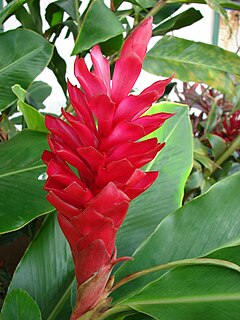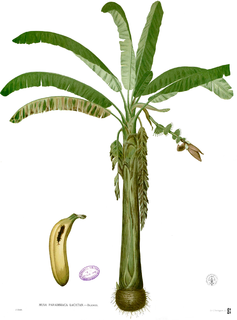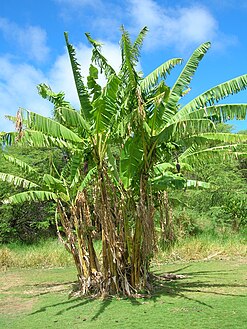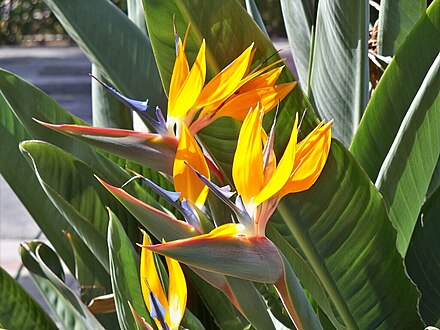
Commelinales is the botanical name of an order of flowering plants. It comprises five families: Commelinaceae, Haemodoraceae, Hanguanaceae, Philydraceae, and Pontederiaceae. All the families combined contain over 885 species in about 70 genera; the majority of species are in the Commelinaceae. Plants in the order share a number of synapomorphies that tie them together, such as a lack of mycorrhizal associations and tapetal raphides. Estimates differ as to when the Comminales evolved, but most suggest an origin and diversification sometime during the mid- to late Cretaceous. Depending on the methods used, studies suggest a range of origin between 123 and 73 million years, with diversification occurring within the group 110 to 66 million years ago. The order's closest relatives are in the Zingiberales, which includes ginger, bananas, cardamom, and others.

Zingiberaceae or the ginger family is a family of flowering plants made up of about 50 genera with a total of about 1600 known species of aromatic perennial herbs with creeping horizontal or tuberous rhizomes distributed throughout tropical Africa, Asia, and the Americas.

Monocotyledons, commonly referred to as monocots, are flowering plants (angiosperms) the seeds of which typically contain only one embryonic leaf, or cotyledon. They constitute one of the major groups into which the flowering plants have traditionally been divided, the rest of the flowering plants having two cotyledons and therefore classified as dicotyledons, or dicots. However, molecular phylogenetic research has shown that while the monocots form a monophyletic group or clade, the dicotyledons do not. Monocotyledons have almost always been recognized as a group, but with various taxonomic ranks and under several different names. The APG III system of 2009 recognises a clade called "monocots" but does not assign it to a taxonomic rank.
The Cronquist system is a taxonomic classification system of flowering plants. It was developed by Arthur Cronquist in a series of monographs and texts, including The Evolution and Classification of Flowering Plants and An Integrated System of Classification of Flowering Plants (1981).

Heliconia, derived from the Greek word Ἑλικώνιος, is a genus of flowering plants in the family Heliconiaceae. Most of the ca 194 known species are native to the tropical Americas, but a few are indigenous to certain islands of the western Pacific and Maluku. Many species of Heliconia are found in the tropical forests of these regions. Several species are widely cultivated as ornamentals, and a few are naturalized in Florida, Gambia and Thailand. Common names for the genus include lobster-claws, toucan beak, wild plantains or false bird-of-paradise. The last term refers to their close similarity to the bird-of-paradise flowers (Strelitzia). Collectively, these plants are also simply referred to as heliconias.
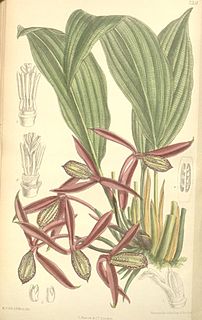
Orchidantha is a genus of flowering plants. In the APG III system, it is placed in the family Lowiaceae, as the sole genus. It includes the plants in the formerly recognised genera Lowia and Protamomum.

The Marantaceae are a family, the arrowroot family, of flowering plants known for its large starchy rhizomes. It is sometimes called the prayer-plant family. Combined morphological and DNA phylogenetic analyses indicate the family originated in Africa, although this is not the center of its extant diversity.

Costaceae, or the Costus family, is a family of pantropical monocots. It belongs to the order Zingiberales, which contains horticulturally and economically important plants such as the banana (Musaceae), bird-of-paradise (Strelitziaceae), and edible ginger (Zingiberaceae). The seven genera in Costaceae together contain about 143 known species. They are native to tropical climates of Asia, Africa, Central America, and South America. Several species are frequently found in cultivation.

The eudicots, Eudicotidae or eudicotyledons are a clade of flowering plants that had been called tricolpates or non-magnoliid dicots by previous authors. The botanical terms were introduced in 1991 by evolutionary botanist James A. Doyle and paleobotanist Carol L. Hotton to emphasize the later evolutionary divergence of tricolpate dicots from earlier, less specialized, dicots. The close relationships among flowering plants with tricolpate pollen grains was initially seen in morphological studies of shared derived characters. These plants have a distinct trait in their pollen grains of exhibiting three colpi or grooves paralleling the polar axis. Later molecular evidence confirmed the genetic basis for the evolutionary relationships among flowering plants with tricolpate pollen grains and dicotyledonous traits. The term means "true dicotyledons", as it contains the majority of plants that have been considered dicots and have characteristics of the dicots. The term "eudicots" has subsequently been widely adopted in botany to refer to one of the two largest clades of angiosperms, monocots being the other. The remaining angiosperms include magnoliids and what are sometimes referred to as basal angiosperms or paleodicots, but these terms have not been widely or consistently adopted, as they do not refer to a monophyletic group.
The APG system of plant classification is the first version of a modern, mostly molecular-based, system of plant taxonomy. Published in 1998 by the Angiosperm Phylogeny Group, it was replaced by the improved APG II in 2003, APG III system in 2009 and APG IV system in 2016.
The Kubitzki system is a system of plant taxonomy devised by Klaus Kubitzki, and is the product of an ongoing survey of vascular plants, entitled The Families and Genera of Vascular Plants, and extending to 13 volumes in 2015. The survey, in the form of an encyclopedia, is important as a comprehensive, multivolume treatment of the vascular plants, with keys to and descriptions of all families and genera, mostly by specialists in those groups. The Kubitzki system served as the basis for classification in Mabberley's Plant-Book, a dictionary of the vascular plants. Mabberley states, in his Introduction on page xi of the 2008 edition, that the Kubitzki system "has remained the standard to which other literature is compared".
A system of plant taxonomy, the Goldberg system was published in:
Scitamineae is a descriptive botanical name. Historically it has been applied to a remarkably stable group of flowering plants, now referred to as Zingiberales:
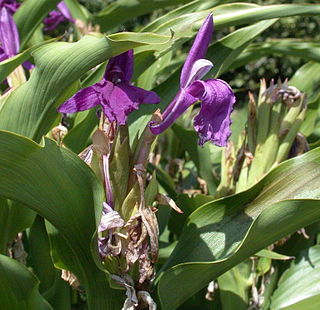
Roscoea is a genus of perennial plants of the family Zingiberaceae. Most members of the family are tropical, whereas Roscoea species are native to mountainous regions of the Himalayas, China and its southern neighbours. Roscoea flowers superficially resemble orchids, although they are not related. The flowers of Roscoea have a complicated structure, in which some of the showy coloured parts are not formed by petals, but by staminodes, sterile stamens which have evolved to become like petals. Some species are grown as ornamental plants in gardens.

Costus curvibracteatus is a tropical rhizomatous perennial native to Costa Rica and Panama. A member of the spiral ginger family of plants, its common name is orange tulip ginger. It is also sometimes referred to as spiral ginger; however, this common name is better associated with Costus barbatus, a more widely cultivated and very similar species. Despite the name and its relation to the ginger family (Zingiberaceae), the rhizomes of the orange tulip ginger are not edible.
Walter John Emil Kress is an American botanist and the vice-president for science at the National Museum of Natural History. He currently holds the appointment (2010) as the Director of the new Consortium for Understanding and Sustaining a Biodiverse Planet at the Smithsonian and is the former Executive Director of the Association for Tropical Biology and Conservation.
